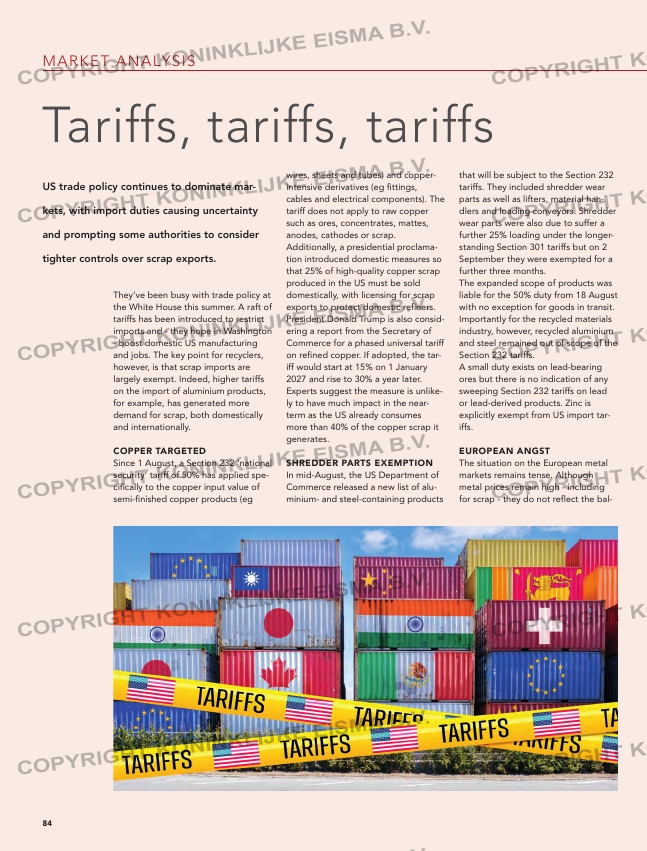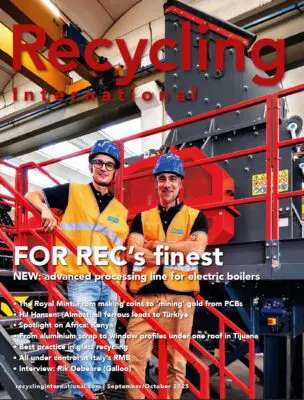Page 92 from: Recycling International September/October 2025

MARKET ANALYSIS
Tariffs, tariffs, tariffs
US trade policy continues to dominate mar-
kets, with import duties causing uncertainty
and prompting some authorities to consider
tighter controls over scrap exports.
ance of supply and demand. Little is
happening in physical trading day-to-
day and the markets remain quiet.
US tariff policy is causing American com-
panies to pay more for aluminium scrap
from Europe, analysts say, which in turn
drives prices upward and burdens the
intra-European market. The European
aluminium industry complains about
excessive prices for scrap, driving calls
for export duties on European scrap.
The market is becoming unsettled.
Reuters has reported that the
European Commission is monitoring
trade flows of scrap metal, including
steel, aluminium and copper, ‘after
stark industry warnings of shortages
and the risk of smelter shutdowns’. A
European Commission statement said:
‘The EU is experiencing a decline in
metal scrap availability … The intro-
duction of a 50% tariff by the United
States on a wide range of steel and
aluminium products (excluding scrap)
may further worsen this issue.’ The
Commission is expected to respond to
the data in late September.
UZBEK TARIFFS
Sentiment in Europe is poor, with little
hope of recovery in global markets. As
a result, more companies in the metals
industry are giving up, either by clos-
ing or selling their businesses. The
number of insolvencies in Europe has
increased significantly. Overall, this is
not a favourable environment for the
European metal market.
Meanwhile, the global copper scrap
market is facing unprecedented con-
straints due to a perfect storm of trade
policies, tariffs and regional supply tight-
ness. An entire source market was elimi-
nated virtually overnight in July when
Uzbekistan implemented a 100% tariff
on scrap metal exports including cop-
per. This is the first time the country has
embraced export restrictions while look-
ing to preserve raw materials for domes-
tic use. In 2024, Uzbekistan supplied 3%
on China’s copper scrap imports.
CHINA BUILDS
Meanwhile, China continues to
increase its domestic production of
non-ferrous scrap and scrap imports.
According to Ma Hongchang in the
84
wires, sheets and tubes) and copper-
intensive derivatives (eg fittings,
cables and electrical components). The
tariff does not apply to raw copper
such as ores, concentrates, mattes,
anodes, cathodes or scrap.
Additionally, a presidential proclama-
tion introduced domestic measures so
that 25% of high-quality copper scrap
produced in the US must be sold
domestically, with licensing for scrap
exports to protect domestic refiners.
President Donald Trump is also consid-
ering a report from the Secretary of
Commerce for a phased universal tariff
on refined copper. If adopted, the tar-
iff would start at 15% on 1 January
2027 and rise to 30% a year later.
Experts suggest the measure is unlike-
ly to have much impact in the near-
term as the US already consumes
more than 40% of the copper scrap it
generates.
SHREDDER PARTS EXEMPTION
In mid-August, the US Department of
Commerce released a new list of alu-
minium- and steel-containing products
that will be subject to the Section 232
tariffs. They included shredder wear
parts as well as lifters, material han-
dlers and loading conveyors. Shredder
wear parts were also due to suffer a
further 25% loading under the longer-
standing Section 301 tariffs but on 2
September they were exempted for a
further three months.
The expanded scope of products was
liable for the 50% duty from 18 August
with no exception for goods in transit.
Importantly for the recycled materials
industry, however, recycled aluminium
and steel remained out of scope of the
Section 232 tariffs.
A small duty exists on lead-bearing
ores but there is no indication of any
sweeping Section 232 tariffs on lead
or lead-derived products. Zinc is
explicitly exempt from US import tar-
iffs.
EUROPEAN ANGST
The situation on the European metal
markets remains tense. Although
metal prices remain high – including
for scrap – they do not reflect the bal-
They’ve been busy with trade policy at
the White House this summer. A raft of
tariffs has been introduced to restrict
imports and – they hope in Washington
– boost domestic US manufacturing
and jobs. The key point for recyclers,
however, is that scrap imports are
largely exempt. Indeed, higher tariffs
on the import of aluminium products,
for example, has generated more
demand for scrap, both domestically
and internationally.
COPPER TARGETED
Since 1 August, a Section 232 ‘national
security’ tariff of 50% has applied spe-
cifically to the copper input value of
semi-finished copper products (eg
A U T H O R Robin Latchem P H O T O Shutterstock
84-85-86_manonferrous.indd 84 09-09-2025 14:23



